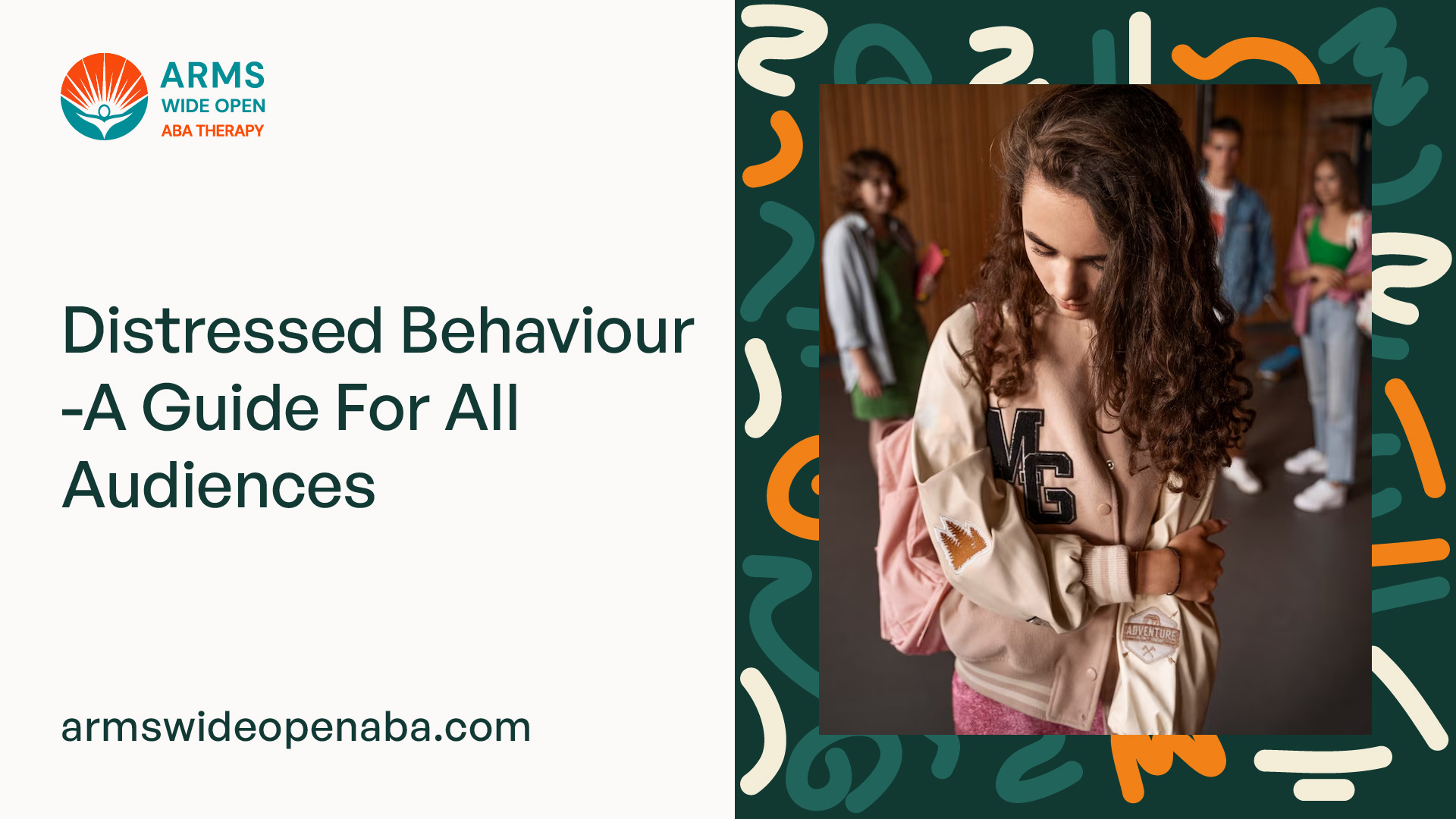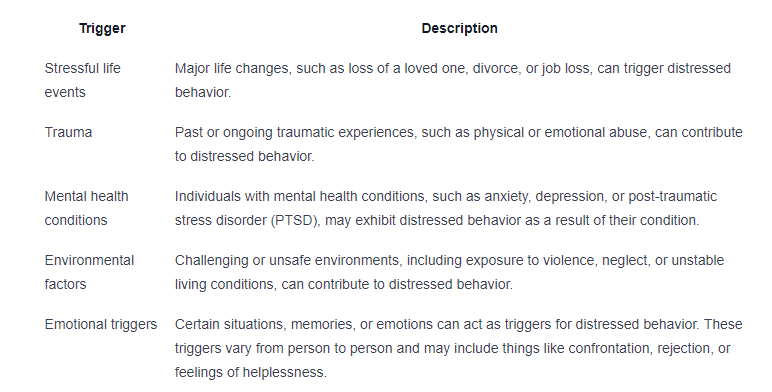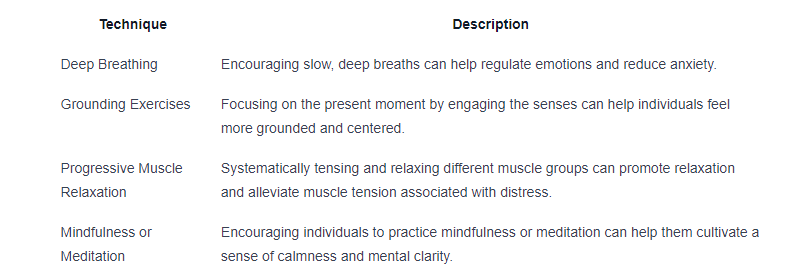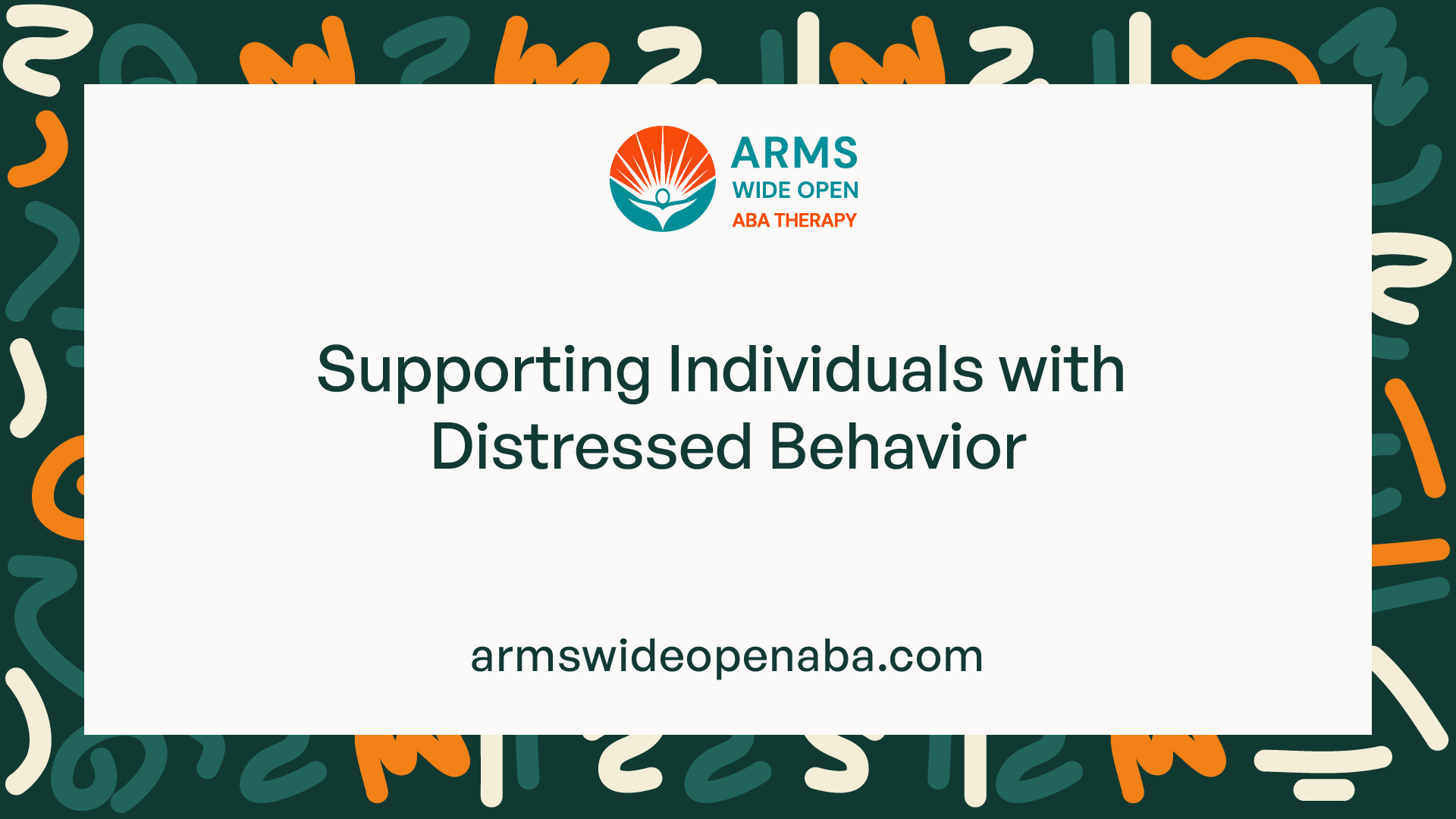Distressed Behavior -A Guide For All Audiences
Crack the code of distressed behavior! A comprehensive guide for all audiences, promoting understanding and empathy.


Understanding Distressed Behavior
When it comes to understanding distressed behavior, it is important to have a clear definition of what it entails and to identify the common triggers that may contribute to it.
Defining Distressed Behavior
Distressed behavior refers to a range of emotional and behavioral responses that individuals may exhibit when they are overwhelmed, in distress, or experiencing intense emotional pain. It is a way for individuals to communicate their inner turmoil and seek help or relief.
Distressed behavior can manifest in various forms, including aggression, withdrawal, self-destructive tendencies, or a combination of these behaviors. It is important to approach distressed behavior with empathy and understanding, recognizing that it is a sign of distress rather than a deliberate attempt to cause harm.
Common Triggers of Distressed Behavior
Distressed behavior can be triggered by various factors, and it is essential to recognize these triggers to better understand and respond to individuals in distress. Some common triggers of distressed behavior include:

By understanding the definition of distressed behavior and recognizing the common triggers, we can begin to develop strategies and approaches to support individuals experiencing distress. It is essential to approach distressed behavior with compassion, empathy, and a willingness to provide the necessary help and support.
Types of Distressed Behavior
Distressed behavior can manifest in various ways, often serving as a signal that an individual is struggling to cope with their emotions or circumstances. Understanding the different types of distressed behavior is essential in providing appropriate support and intervention. This section explores three common types of distressed behavior: aggressive behavior, withdrawal behavior, and self-destructive behavior.
Aggressive Behavior
Aggressive behavior is characterized by actions or expressions that are intended to cause harm or distress to oneself or others. It may involve physical, verbal, or emotional aggression. Individuals displaying aggressive behavior may exhibit anger, hostility, or a lack of impulse control. The table below outlines some examples of aggressive behavior.
Examples of Aggressive Behavior
Physical violence
Verbal threats or insults
Intense anger outbursts
Property destruction
Withdrawal Behavior
Withdrawal behavior refers to a retreat or disengagement from social interactions and activities. Individuals displaying withdrawal behavior may isolate themselves, avoid social gatherings, and have a general disinterest in their surroundings. This behavior can be an indication of emotional distress or a coping mechanism to protect oneself. The table below provides examples of withdrawal behavior.
Examples of Withdrawal Behavior
Social isolation
Avoidance of conversation
Loss of interest in hobbies
Spending excessive time alone
Self-Destructive Behavior
Self-destructive behavior involves actions that harm oneself physically or emotionally. It is often a result of deep emotional pain or a lack of healthy coping mechanisms. Individuals engaging in self-destructive behavior may engage in activities such as self-harm, substance abuse, or risky behaviors. The table below presents examples of self-destructive behavior.
Examples of Self-Destructive Behavior
Self-harm (e.g., cutting, burning)
Substance abuse (e.g., excessive alcohol or drug use)
Engaging in risky behaviors
Extreme risk-taking
Recognizing the different types of distressed behavior can help us identify when someone is in need of support and intervention. It is important to approach individuals displaying these behaviors with empathy and understanding, while also seeking professional help when necessary. By addressing distressed behavior with care and compassion, we can contribute to a safer and more supportive environment for everyone involved.

Causes of Distressed Behavior
Distressed behavior can manifest in various forms and can arise from a variety of factors. Understanding the underlying causes of distressed behavior is crucial for effectively addressing and supporting individuals. Here, we will explore the three main categories of causes: environmental factors, psychological factors, and social factors.
Environmental Factors
Environmental factors play a significant role in influencing distressed behavior. These factors refer to the external circumstances and conditions that individuals are exposed to. They can include:
Environmental Factors
Traumatic events
Chronic stress
Unstable living conditions
Financial difficulties
Substance abuse in the environment
Experiencing traumatic events, such as natural disasters or personal crises, can trigger distressed behavior. Chronic stress and unstable living conditions can also contribute to feelings of anxiety and distress. Financial difficulties and the presence of substance abuse in the environment can further exacerbate distress.
Psychological Factors
Psychological factors refer to the internal mental and emotional processes that contribute to distressed behavior. These factors can include:
Psychological Factors
Mental health disorders
Trauma
Low self-esteem
Negative thought patterns
Inability to cope with emotions
Individuals with pre-existing mental health disorders, such as depression, anxiety, or post-traumatic stress disorder (PTSD), are more susceptible to distressed behavior. Additionally, past traumatic experiences, low self-esteem, negative thought patterns, and difficulties in coping with emotions can also contribute to distress.
Social Factors
Social factors refer to the social environment and interpersonal relationships that individuals are a part of. These factors can include:
Social Factors
Relationship conflicts
Peer pressure
Bullying
Social isolation
Lack of support networks
Relationship conflicts, whether within the family, romantic partnerships, or friendships, can contribute to distressed behavior. Peer pressure and bullying can also greatly impact an individual's emotional well-being. Social isolation and a lack of support networks can further exacerbate distress, as individuals may feel disconnected and unsupported.
Understanding these causes of distressed behavior helps to shed light on the complex interplay between internal and external factors. By recognizing and addressing these underlying causes, it becomes possible to provide appropriate support and intervention for individuals experiencing distress.
Responding to Distressed Behavior
When faced with distressed behavior, it's important to respond in a calm and compassionate manner. Understanding effective strategies can help de-escalate the situation and provide support to individuals in distress. This section will explore various techniques to respond to distressed behavior, including calming techniques, communication strategies, and the importance of seeking professional help when necessary.
Calming Techniques
Calming techniques are valuable tools to help individuals in distress regain a sense of control and emotional stability. These techniques can be used by both the individual experiencing distress and those providing support. Here are a few examples of calming techniques:

These techniques can vary in effectiveness depending on the individual, so it's essential to provide options and support the person in finding what works best for them.
Communication Strategies
Effective communication is key when responding to distressed behavior. It's important to approach the situation with empathy, patience, and active listening. Some communication strategies that can help de-escalate distress include:
- Stay Calm: Maintain a calm and composed demeanor to help create a sense of safety and stability.
- Active Listening: Give the individual your full attention, validate their feelings, and demonstrate empathy by reflecting their emotions.
- Use Non-Threatening Language: Choose words and tone that are non-confrontational and non-judgmental to avoid further distressing the individual.
- Provide Reassurance: Offer reassurance and let the person know that they are not alone. Remind them that you are there to support them.
- Avoid Arguing or Challenging: During a distressed episode, it's important to prioritize the person's emotional well-being over winning an argument. Focus on understanding and finding resolution rather than engaging in confrontations.
Remember, effective communication involves both verbal and non-verbal cues. Pay attention to body language, use a calm tone of voice, and maintain respectful eye contact to convey understanding and support.
Seeking Professional Help
While calming techniques and communication strategies can be helpful in many situations, it's important to recognize when professional help is needed. If distressed behavior becomes frequent, severe, or poses a risk to the individual or others, seeking professional assistance is crucial. Mental health professionals, such as psychologists, therapists, or counselors, can provide specialized guidance and support tailored to the individual's needs.
Encourage individuals experiencing distress to seek professional help if they haven't already done so. Provide them with information about available resources, such as mental health hotlines or local mental health clinics. Remember, professional help can make a significant difference in managing and understanding distressed behavior, ensuring the individual receives the appropriate care and support they need.
By employing calming techniques, using effective communication strategies, and recognizing the importance of professional help, we can respond to distressed behavior in a supportive and compassionate manner.

Supporting Individuals with Distressed Behavior
When someone is experiencing distressed behavior, it is important to provide them with the support they need. Here are three key ways to support individuals who are going through distress:
Providing Emotional Support
Emotional support plays a crucial role in helping individuals cope with distressed behavior. By offering empathy, understanding, and a listening ear, you can create a safe space for them to express their feelings and concerns. Here are some strategies for providing emotional support:
- Be present and attentive: Show genuine interest and actively listen to their thoughts and emotions without judgment.
- Validate their feelings: Acknowledge and validate their emotions, letting them know that their feelings are valid and understood.
- Offer reassurance: Provide comfort and reassurance that they are not alone and that you are there to support them.
- Encourage open communication: Encourage open and honest communication, allowing them to express their thoughts and fears without fear of judgment.
- Be patient and non-judgmental: Understand that recovery takes time, and avoid rushing or pressuring them to "get better" quickly.
Creating a Safe Environment
Creating a safe and supportive environment is crucial for individuals experiencing distressed behavior. A safe environment can help reduce anxiety, provide stability, and promote overall well-being. Here are some ways to create a safe environment:
- Ensure physical safety: Remove any potential hazards or triggers that may cause harm or distress.
- Maintain a calm atmosphere: Create a peaceful and calming environment by reducing noise, providing privacy, and minimizing distractions.
- Establish boundaries: Set clear boundaries and guidelines to ensure everyone feels safe and respected.
- Foster a sense of belonging: Create a supportive and inclusive atmosphere where individuals feel accepted and valued.
- Encourage self-expression: Provide opportunities for creativity and self-expression, such as through art, writing, or other therapeutic activities.
Encouraging Self-Care
Self-care plays a vital role in supporting individuals with distressed behavior. Encouraging self-care practices can help promote emotional well-being and provide individuals with coping mechanisms to manage their distress. Here are some self-care strategies to encourage:
- Encourage relaxation techniques: Encourage individuals to practice relaxation techniques such as deep breathing, meditation, or mindfulness exercises.
- Promote healthy habits: Encourage a balanced lifestyle by emphasizing the importance of regular exercise, nutritious meals, and adequate sleep.
- Support hobbies and interests: Encourage individuals to engage in activities they enjoy and find fulfilling, such as hobbies, sports, or creative pursuits.
- Provide access to resources: Connect individuals with resources that can support their self-care efforts, such as counseling services, support groups, or online mental health resources.
- Foster a supportive network: Encourage individuals to seek support from friends, family, or support groups, as connecting with others can provide a sense of belonging and understanding.
By providing emotional support, creating a safe environment, and encouraging self-care, you can play a vital role in supporting individuals experiencing distressed behavior. Remember, every person is unique, and the level of support needed may vary. It is essential to be understanding, patient, and flexible in your approach to meet their individual needs.
Breaking the Stigma
Distressed behavior is often misunderstood and stigmatized, leading to negative perceptions and inadequate support for individuals experiencing it. Breaking the stigma surrounding distressed behavior is crucial for promoting understanding, empathy, and mental health awareness. Here are three important ways to contribute to this cause:
Educating Others
Education plays a vital role in dispelling misconceptions and fostering empathy towards distressed behavior. By sharing accurate information and personal experiences, we can help others understand the complexities and challenges individuals facing distress encounter. Some key points to address when educating others include:
- Explaining that distressed behavior is not a choice, but a manifestation of underlying struggles.
- Highlighting that distressed behavior is not indicative of weakness or character flaws.
- Emphasizing the importance of empathy, patience, and support when interacting with individuals experiencing distress.
- Promoting the understanding that distressed behavior can affect anyone, regardless of age, gender, or background.
Promoting Understanding and Empathy
Building understanding and empathy is essential for creating a supportive environment for individuals with distressed behavior. By encouraging open conversations and fostering a non-judgmental atmosphere, we can help break down the barriers that prevent people from seeking help or understanding. Here are some ways to promote understanding and empathy:
- Encouraging active listening and validation of individuals' experiences and emotions.
- Challenging stereotypes and preconceived notions about distressed behavior.
- Encouraging compassion and empathy towards those who may be struggling.
- Promoting a culture of empathy and support within families, schools, workplaces, and communities.
Advocating for Mental Health Awareness
Advocacy plays a significant role in normalizing discussions around mental health and distressed behavior. By raising awareness and advocating for mental health, we can contribute to reducing stigma and ensuring that individuals have access to the support and resources they need. Some ways to advocate for mental health awareness include:
- Participating in mental health campaigns and events to promote dialogue and raise awareness.
- Supporting organizations that focus on mental health education, research, and advocacy.
- Encouraging policymakers to prioritize mental health initiatives and allocate resources for mental health services.
- Sharing personal stories and experiences to inspire others and reduce the sense of isolation associated with distressed behavior.
Breaking the stigma surrounding distressed behavior requires collective effort and a commitment to promoting understanding, empathy, and mental health awareness. By educating others, promoting understanding and empathy, and advocating for mental health, we can create a society that fosters support, acceptance, and well-being for individuals experiencing distress.
Sources
https://www.autism.org.uk/advice-and-guidance/topics/behaviour/distressed-behaviour/all-audiences
https://www.pdasociety.org.uk/life-with-pda-menu/family-life-intro/distressed-behaviours/
Similar articles
We’re here to help you

Our team is here to assist you in this process. Contact us for any assistance.
it’s easy to apply
We Accept Most Insurances
Our in-network insurance partnerships make ABA therapy more accessible to families throughout our service areas.







Our Insurance Process
We'll request your insurance details to help us verify your plan's coverage for ABA therapy. Once we've received this information, we'll walk you through your benefits, including copayments, deductibles and out-of-pocket maximums, so you know what to expect in advance.
Our team will then handle the preauthorization and all the necessary paperwork.
.svg)





















.jpeg)


































.jpeg)




.jpeg)







.jpeg)











.jpeg)
















